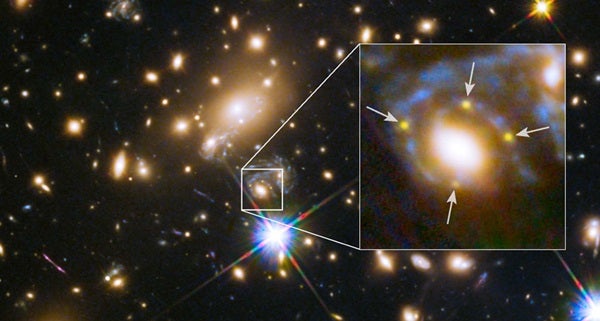In November 2014, Patrick Kelly was looking through his team’s recently collected Hubble Space Telescope images of galaxy cluster MACS J1149.6+2223 when something stood out: four stars with exactly the same pattern of light surrounding one of the cluster’s member galaxies. “I knew it was a big discovery,” says Kelly, a postdoctoral fellow at the University of California, Berkeley. He emailed his group about the find, and they have since confirmed it as a supernova whose image has been distorted by the cluster galaxy, which lies along the supernova’s line of sight. Months of observations have classified this object as a type IIp supernova, which originated from a massive star.
The distant stellar explosion lies more than halfway across the observable universe. Its light left the supernova some 9.5 billion years ago. Along its path to Earth, the light encountered a massive member of the intervening galaxy cluster. The galaxy warps the fabric of space-time like a bowling ball warps a trampoline, and so the supernova’s light follows those curves in space-time, detoured from its path to Hubble.
This “gravitational lensing” causes the light to appear to come from four different points instead of just one lone supernova. Norwegian astrophysicist Sjur Refsdal predicted this type of quadruple-lensed supernova 50 years ago. The 2014 discovery, published in the March 6, 2015, issue of Science, has been named Supernova Refsdal after that scientist.
In his 1964 paper, Refsdal said such a blast could help to measure the rate our universe is expanding. Because the explosion’s images show up in four locations, light followed four different paths to arrive at Hubble. Astronomers can use each of those paths to map the distribution of normal material and unseen dark matter in the galaxy cluster. In addition, those different paths are related to the cosmic expansion rate.
Another spectacle awaits the team. All of those paths also take a different travel time. After creating a map of MACS J1149.6+2223, the astronomers realized that the supernova should have taken a fifth path, too. The light is still traveling and could appear as early as late 2015, says Kelly.










